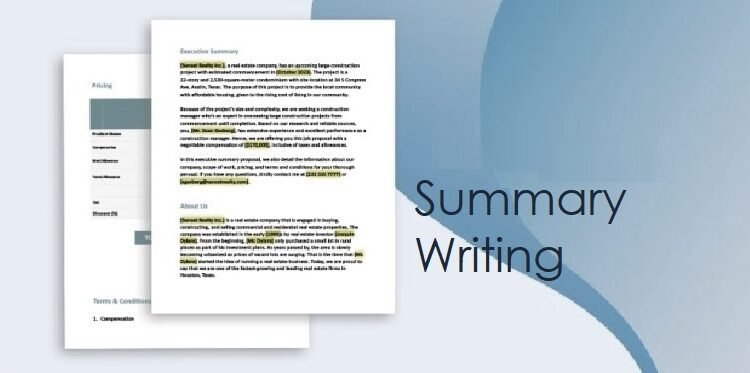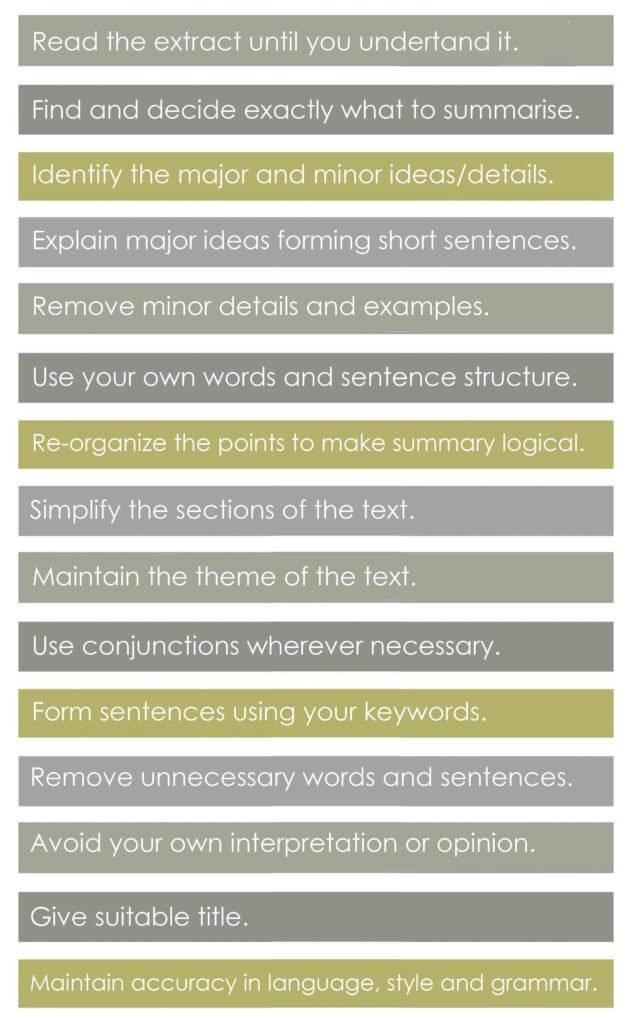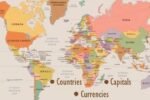Summary Writing: Meaning and Examples

What is Summary Writing?
Summary writing is the process of condensing a longer text or passage into a shorter version, focusing on its main ideas and key points while omitting unnecessary details, examples, or repetitions. It is a short statement that summarizes or informs the audience of the main ideas of a longer piece of writing. Essentially, the summary is a short version of a longer text. The purpose of a summary is to provide a clear and concise understanding of the original content in fewer words. Summary writing is an essential skill for effective communication and comprehension in both academic and professional contexts.
Features of Summary Writing
- Brevity: A summary should be much shorter than the original text.
- Clarity: It should clearly convey the main ideas of the original text.
- Objectivity: A summary should be neutral and avoid adding personal opinions or interpretations.
- Accuracy: The meaning of the original text must be preserved without distorting the message.
Purpose of Summary Writing
- To Save Time: Summaries provide a quick overview of lengthy texts.
- To Aid Understanding: Summaries simplify complex content by highlighting essential information.
- For Academic and Professional Use: Summaries are widely used in education, research, and business for analyzing and presenting information efficiently.
Effective steps to write Summary

(Video courtesy: ‘Iken Edu’ Youtube Channel)
Examples
Title: The Challenges of Climate Change
Passage:
Climate change is one of the most pressing global issues of the 21st century. It refers to significant changes in the Earth’s climate patterns, primarily caused by human activities such as deforestation, industrialization, and the burning of fossil fuels. These activities release large amounts of greenhouse gases into the atmosphere, trapping heat and leading to global warming. The consequences of climate change are evident and severe. Rising sea levels threaten coastal cities, while extreme weather events such as hurricanes, floods, and droughts disrupt livelihoods. Wildlife is also affected, with many species facing extinction due to habitat loss and changing ecosystems.
Efforts to combat climate change include international agreements like the Paris Accord, where countries commit to reducing carbon emissions. Renewable energy sources, such as solar and wind power, offer sustainable alternatives to fossil fuels. Individuals can contribute by conserving energy, reducing waste, and adopting eco-friendly practices. However, these solutions require global cooperation and significant investment. Developing nations face the additional challenge of balancing economic growth with environmental sustainability.
Addressing climate change demands collective action, from policymakers to ordinary citizens. The urgency to act cannot be overstated, as the choices made today will determine the future of the planet for generations to come.
Summary:
Climate change, driven by deforestation and fossil fuel use, leads to global warming, rising sea levels, and extreme weather. It disrupts ecosystems, threatening wildlife and human livelihoods. Efforts like the Paris Accord and renewable energy adoption aim to reduce carbon emissions. Individuals contribute by conserving energy and reducing waste. However, balancing economic growth with sustainability remains a challenge, particularly for developing nations. Addressing climate change requires global cooperation and significant investment. Urgent action is crucial to ensure a sustainable future for generations.
Title: The Importance of Digital Literacy
Passage:
Digital literacy refers to the ability to use digital technology effectively and responsibly. In today’s interconnected world, it is a vital skill that goes beyond basic computer knowledge. Digital literacy encompasses understanding online safety, evaluating the credibility of information, and communicating effectively in digital spaces. It is essential for education, employment, and social interaction.
The integration of technology in education highlights the importance of digital literacy. Students need skills to access online resources, complete digital assignments, and collaborate on virtual platforms. Similarly, in the workplace, digital tools enhance productivity, streamline communication, and drive innovation. Employers now prioritize candidates with strong digital literacy skills.
However, a significant digital divide persists. Many individuals, particularly in rural and underprivileged areas, lack access to technology and the internet. This gap hinders their educational and economic opportunities. Governments and organizations must address this issue by investing in infrastructure, providing affordable internet access, and promoting digital education.
Digital literacy also involves understanding the ethical aspects of technology use. Responsible online behavior, respecting privacy, and avoiding misinformation are crucial components. As technology continues to evolve, digital literacy will remain a cornerstone of personal and professional growth, enabling individuals to navigate the digital age effectively.
Summary:
Digital literacy, the ability to use technology responsibly, is vital for education, employment, and communication in today’s world. It includes online safety, evaluating information, and ethical behavior. In education, it enables students to access resources and collaborate. In the workplace, it enhances productivity and innovation. Despite its importance, the digital divide limits access for rural and underprivileged populations. Responsible technology use, including respecting privacy and avoiding misinformation, is essential. As technology evolves, digital literacy remains crucial for personal and professional success in the digital age.
Title: The Role of Mental Health in Modern Society
Passage:
Mental health is a critical aspect of overall well-being, yet it is often overlooked or stigmatized. It encompasses emotional, psychological, and social well-being, influencing how individuals think, feel, and interact with others. Mental health issues, such as anxiety, depression, and stress, affect millions globally, impacting productivity, relationships, and quality of life.
Modern lifestyles, characterized by high stress, social isolation, and constant digital connectivity, contribute to mental health challenges. Workplace pressures, academic competition, and financial instability are common stressors. Despite the prevalence of mental health issues, many hesitate to seek help due to stigma and lack of awareness.
Promoting mental health requires a multi-faceted approach. Open conversations, access to therapy, and workplace policies that prioritize well-being are essential. Governments must invest in mental health services and education to reduce stigma. Practices like mindfulness, exercise, and healthy lifestyles play a significant role in prevention.
As society evolves, the importance of mental health is increasingly recognized. Addressing mental health challenges is not only a personal responsibility but also a collective effort to create a supportive environment that fosters emotional resilience and societal well-being.
Summary:
Mental health affects emotional, psychological, and social well-being, impacting relationships and productivity. Modern lifestyles contribute to issues like anxiety and depression. Solutions include open conversations, access to therapy, and supportive workplace policies. Governments must invest in mental health services and education to reduce stigma. Preventive measures, including mindfulness and healthy lifestyles, promote resilience. Recognizing mental health’s importance ensures societal well-being.
Title: Renewable Energy for a Sustainable Future
Passage:
Renewable energy, derived from natural sources such as sunlight, wind, and water, is crucial for combating climate change. Unlike fossil fuels, renewables produce minimal greenhouse gas emissions, making them environmentally friendly. The adoption of renewable energy technologies, including solar panels and wind turbines, has accelerated in recent years due to declining costs and increasing awareness of their benefits.
Transitioning to renewable energy is vital for reducing air pollution, enhancing energy security, and creating jobs. However, challenges such as high initial costs, reliance on weather conditions, and the need for advanced storage solutions hinder its widespread adoption. Governments and private sectors must collaborate to invest in research and infrastructure. Public awareness campaigns and incentives can also encourage individuals to adopt green energy solutions.
Renewable energy offers a sustainable alternative to fossil fuels, but its potential can only be fully realized through innovation and global cooperation. Embracing renewables is not just an environmental necessity but also an economic opportunity to ensure a healthier and more sustainable future for all.
Summary:
Renewable energy, sourced from sunlight, wind, and water, is essential for combating climate change and reducing air pollution. It offers environmental and economic benefits, including job creation and energy security. Challenges like high costs and weather dependency require investment in research, infrastructure, and innovation. Governments and private sectors must collaborate, while public awareness and incentives can drive adoption. Transitioning to renewable energy ensures a sustainable and environmentally friendly future.
Title: The Evolution of Artificial Intelligence
Passage:
Artificial intelligence (AI) has transformed various industries by enabling machines to perform tasks that typically require human intelligence. From healthcare to finance, AI applications have improved efficiency and decision-making. Machine learning, a subset of AI, allows systems to learn from data and improve over time without explicit programming.
AI enhances customer experiences through chatbots and personalized recommendations. In healthcare, it aids in early diagnosis and treatment, while in finance, it detects fraud and automates trading. However, the rapid advancement of AI raises ethical concerns, including job displacement, data privacy, and decision-making transparency. Ensuring that AI systems are unbiased and secure is essential for ethical integration.
The future of AI holds immense potential, with innovations in autonomous vehicles, robotics, and advanced problem-solving. To harness its benefits while minimizing risks, governments, organizations, and researchers must work together to establish ethical guidelines and regulations. AI is not just a technological advancement but a transformative force shaping the future of humanity.
Summary:
AI, capable of tasks requiring human intelligence, revolutionizes industries like healthcare and finance by enhancing efficiency and decision-making. While it offers innovations like chatbots and fraud detection, ethical concerns, including job displacement and data privacy, arise. Collaboration among governments, organizations, and researchers is needed to ensure unbiased and secure AI integration. Future advancements in robotics and automation highlight AI’s transformative potential.
Title: The Value of Cultural Diversity
Passage:
Cultural diversity enriches societies by bringing together people with varied traditions, beliefs, and experiences. It fosters creativity and innovation by exposing individuals to new perspectives and ways of thinking. In multicultural societies, cultural exchange promotes mutual respect and understanding, reducing prejudice and stereotypes.
However, cultural diversity can also present challenges, including language barriers and social tensions. Effective communication and inclusivity are key to addressing these issues. Governments and organizations play a vital role in creating policies that celebrate diversity while ensuring equal opportunities for all. Education systems must also emphasize cultural awareness and sensitivity to prepare individuals for a globalized world.
Celebrating cultural diversity strengthens social cohesion and encourages collaboration. It allows societies to draw on the strengths of their diverse populations, fostering growth and progress. Embracing diversity is not only a moral responsibility but also a pathway to a harmonious and thriving global community.
Summary:
Cultural diversity fosters creativity, innovation, and mutual respect by exposing societies to varied traditions and perspectives. While challenges like language barriers exist, inclusivity and education promote understanding. Governments and organizations must create policies that celebrate diversity and ensure equal opportunities. Embracing cultural diversity enhances social cohesion and strengthens societies.
Title: Medical Tourism in India
Passage:
The government of India is encouraging medical tourism in the country by offering tax benefits and export incentives to the participating hospitals. Medical visas are being cleared quickly without any hassles. With a view to facilitating the growth of medical tourism industry, the Ministry of Health and Family Welfare along with the Ministry of Tourism has set up a task force to evaluate the opportunities in the industry. Efforts are being made to standardize procedures and to guide foreign patients to select the hospitals most suited to their needs. Meanwhile, several private hospitals are seeking to take advantage of the booming medical tourism industry and are investing hugely in acquiring equipments and skills.
However, medical tourism carries some risks that locally provided medical care does not. Some countries like India, Malaysia and Thailand have very different infectious diseases rarely found in Europe and North America. Exposure to diseases without having built-up natural immunity can be a hazard for weak individuals specially with respect to gastrointestinal diseases like Hepatitis A, amoebic dysentery etc., which could slow down the recovery process. Also, medical tourists may be at risk from mosquito-transmitted diseases, influenza and tuberculosis. The quality of post-operative care can also vary dramatically depending on the hospital and the country. Finally, after returning home, a patient has a limited contact with their surgeon. This may make it difficult to deal with any complications that may arise later, such as delayed infection.
The concept of medical tourism raises some important questions regarding accessibility, affordability and ethics in medical care. It is unfortunate that a large section of the Indian population has little or no access to private health care. Public health care system is inadequate and lacks proper infrastructure and facilities. One wonders if it is sensible to make provisions for medical tourism in a democratic country like India, which has failed to provide nourishment, sanitation and health care to its masses.
Summary:
The Indian government is promoting medical tourism by offering tax benefits, export incentives, and fast-track medical visas. A task force, consisting of the Ministry of Health and Family Welfare and the Ministry of Tourism, is working to evaluate opportunities and standardize procedures. Private hospitals are investing in advanced equipment and skills to cater to the growing demand for medical tourism. However, medical tourism has associated risks, including exposure to local diseases like Hepatitis A and amoebic dysentery. There are concerns about limited access to health care for India’s local population.
Title: Father’s Laughter
Passage:
When my father laughs, it is not only our home that reverberates but the adjacent houses feel the ripples as well. He loves to laugh – only now, at a ripe old age. In our younger days we hardly remember seeing or hearing him laugh. He may have laughed in the company of his friends, but not at home. My father, a professor of English, had ‘rigid. cold eyes’. His eyes never flickered, penetrating deep into the person in front, if he happened to be the target, enough to upset him from his seat. And they were cold not from an absence of warmth, but like steel that had been tempered. Of course, it was not for us to question why his eyes were cold or why he rarely laughed at home. Ours was to accept his authority in order to live.
Every morning, we would try to gauge father’s mood from the movement of his eyes or the few words he spoke. If his voice didn’t have a rough edge, we would breathe and move around a bit freely. On the other hand, when his throat produced grunts and rumbles, we knew we had had it for the day. The most difficult situation was when he was silent. Unable to read him, we would be on the horns of a dilemma: Was it fine to go for a football match? Or, would that invite a fine of two slaps, if not three penalty kicks? My father’s moods were like Chennai’s climate- hot, hotter, hottest. Yet, like millions of Madrasis who have not only survived their city’s climate but have also grown to love it, we came to love our father the way he was. He kept us on a tight leash with his stern countenance. fearing that we would go astray if given any liberties. Discipline was his motto, perhaps inherited from his own English professors. For that, I am grateful to him. At the end of the day, he exudes a quiet smile of satisfaction at having reared a brood of worthy citizens, if not exactly highly ‘valuable’ ones. Freed now from the burden of bringing up children, my father has dispensed with his rigid, cold facade. And he laughs a lot. He has to unload all those cans of laughter in him that had their lids, screwed on for so long. So it’s not strange that my children refuse to believe that their grandfather and laughter were ever strangers.
Summary:
As a child, the narrator’s father, a strict English professor, rarely laughed at home. His cold, serious demeanor and penetrating gaze set the tone for the household. The family often tried to gauge his mood, knowing that discipline was his priority. Despite this, the narrator appreciated the values his father instilled. With age, his father’s sternness softened, and he began to laugh freely. This change surprised the narrator’s children, who couldn’t imagine their grandfather being serious. His laughter, once held back, now symbolizes his release from the burdens of parenting.
Title: Tolerance in Public Life
Passage:
Love is a great force in private life, it is indeed the greatest of all things; but love in public affairs does not work. It has been tried again and again; by the people of the Middle Ages, and also by the French Revolution, a secular movement which reasserted the Brotherhood of man. And it has always failed. The idea that nations should love one another, or that business concerns or marketing boards should love one another or that a man in Portugal should love a man in Peru of whom he has never heard – it is absurd, unreal, dangerous. ‘Love is what is needed,’ we chant, and then sit back and the world goes on as before. The fact is we can only love what we know personally. And we cannot know much. In public affairs, in the rebuilding of civilization, something much less dramatic and emotional is needed, namely tolerance. Tolerance is a very dull virtue. It is boring. It is negative. It merely means putting up with people, being able to stand things. No one has ever written an ode to tolerance, or raised a statute to her. Yet this is the quality which will be most needed after the war. This is the sound state of mind we are looking for. This is the only force, which will enable different races and classes and interests to settle down together to the work of reconstruction.
The world is very full of people – appallingly full; it has never been so full before, and they are all tumbling over each other. Most of these people on doesn’t like. Well, what is one to do? If you don’t like people, put up with them as well as you can. Don’t try to love them; you can’t. But try to tolerate them. On the basis of that tolerance a civilized future may be built. Certainly I can see no other foundation for the post-war world. Summarize this passage in 120 words with suitable title.
Summary:
Love is important in personal relationships, but it doesn’t work in public life. Attempts to use love between countries, businesses, or even distant people have failed. We can only truly love those we know well. In public matters, what we need is tolerance. Tolerance may seem boring, but it’s necessary for people to live together peacefully. It means accepting others and getting along despite differences. After a war, tolerance is crucial for rebuilding society. The world is full of people, and many may not be easy to like. Instead of trying to love everyone, we must learn to tolerate them. Tolerance is the foundation for a better future.
Title: Kalpana Chawla’s Love for India
Passage:
Kalpana Chawla was extremely proud of her birth-place and made every effort to bring it into the lime-light. During space flights she would proudly point it out to her fellow-astronauts. Once, during the second flight she remembered her closest friend, Daisy Chawla, who died in a road accident. In fact, despite her celebrity status she took pains to track down her former teachers, classmates and friends in India and showed a keen desire to stay in touch with them. Her affectionate and humble nature won the hearts of all who came in contact with her.
Although Kalpana had a strong desire to go to Mars, fly over its canyons and die in space, she was equally concerned about the well-being of the earth. She always urged young people to listen to the sounds of nature and take care of our fragile planet. During her space trips, she took many breathtaking photographs of the earth for various torrential studies later on the ground. When she was in space, she always felt a sense of connection with everyone on the earth.
It was Kalpana’s cherished desire to visit India again. But that was not to be. A few months after her tragic death, Harrison visited India. He went to her school and college, met her family, teachers and friends and scattered her ashes over the Himalayas.
Summary:
Kalpana Chawla was very proud of her birthplace and always shared it with others during her space flights. She remembered her close friend, Daisy Chawla, who passed away in a road accident, and remained in touch with her teachers, classmates, and friends in India. Known for her humility and kindness, she touched the hearts of everyone she met. Kalpana dreamed of exploring Mars but was also deeply concerned about the earth’s well-being. She encouraged young people to care for the planet and took many photos of the earth during her space missions. Her dream of visiting India again was unfulfilled. After her tragic death, her ashes were scattered over the Himalayas.
Our Categories:
| STATES BOARDS | CBSE BOARD |
| SPOKEN ENGLISH | GRAMMAR |
| GK | QUIZ |






